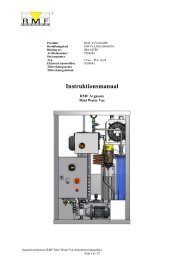CMS/User Guide - Filterteknik
CMS/User Guide - Filterteknik
CMS/User Guide - Filterteknik
You also want an ePaper? Increase the reach of your titles
YUMPU automatically turns print PDFs into web optimized ePapers that Google loves.
The user connects the <strong>CMS</strong> between two points in the hydraulic circuit,that have this pressure difference.In order to use the graph:• Determine the working viscosity of the fluid, e.g. 30 cSt.• Decide on a desired flow rate. 200ml/minute is normally usedsince this is in the middle of the <strong>CMS</strong> flow range. But 100ml/minuteis also suitable and uses less oil.• Use the graph 15.4 to look up the pressure drop, across the <strong>CMS</strong>ports, at this flow rate and viscosity. E.g. at 30cSt and 200ml/minute,this is 0.4 Bar. The maximum and minimum allowed differentialpressures can also be determined using the 400ml/min and20ml/min lines, respectively.• Determine the additional pressure drop caused by the pipingused to connect the <strong>CMS</strong>. This may be negligible for 1/4 inchpiping and over, but is very important for "Mini-mess’’ hoses.This information can be found in the manufacturers catalogues.In the case of Mini-mess hoses, at 30 cSt these have a pressuredrop of around 10 Bar per meter per lpm of flow. So a 2m totalhose length would add a pressure drop of 2 × 10 × 0.2 = 4 Bar.(So in this case the pressure-flow relationship is mainly dependenton hose resistance.)• Add the <strong>CMS</strong> pressure drop to that of the hoses, e.g. 4 + 0.4 =4.4 Bar.When the required pressure drop has been found:Hydraulic Connection 51





